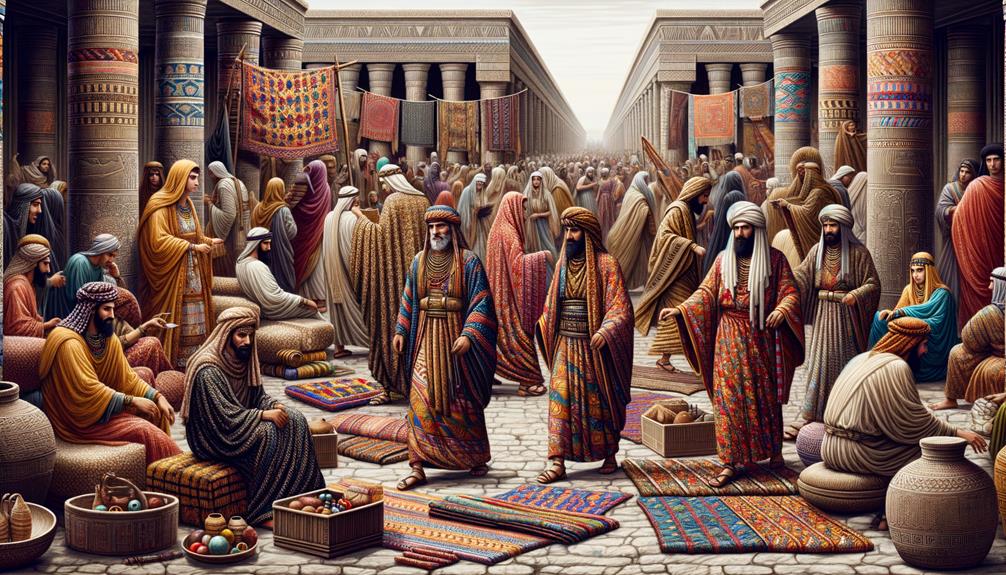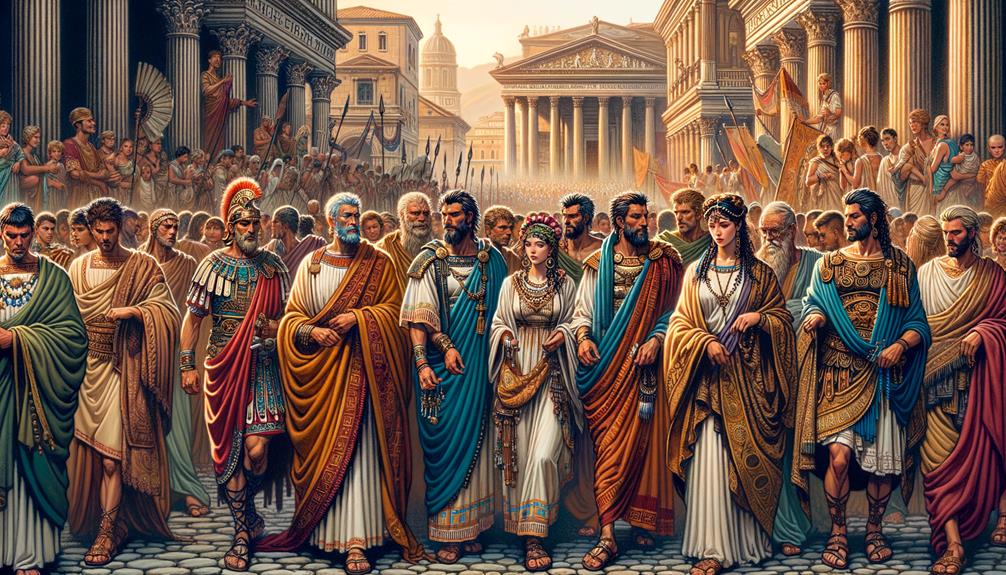In ancient Egypt, fashion was a delicate balance of elegance and practicality. Men wore linen kilts, which were well-suited for the hot climate. Women wore flowing linen dresses adorned with intricate beading that caught the eye. Sandals, made from papyrus and leather, showcased the artisans’ skill through their simplicity. Jewelry spoke volumes; gold and semi-precious stones sparkled on wrists and necks, while wigs made from human hair crowned the nobility. Each piece, from the sheer blouses of scribes to the gilded robes of pharaohs, told a story of status and identity, weaving a narrative that only the curious might uncover further.
Clothing Materials
As I strolled along the Nile River, I couldn’t help but marvel at the ancient Egyptians’ fabric of choice: linen. This lightweight, breathable fabric seemed to flutter effortlessly, offering respite from the scorching sun. Linen, derived from the flax plant, was not just a practical necessity but also a status symbol for the wealthy, who could afford its finer, lighter-weight varieties.
In contrast, the ancient Egyptians also used other clothing materials. Leather, for instance, played a crucial role in protective clothing. Shields and armor crafted from leather offered durability and a measure of safety in both daily life and warfare. What struck me was how the same material that provided protection also symbolized strength and resilience.
Wool, on the other hand, was a rare sight in everyday wear in this hot climate. Considered impure, it was rarely seen in ancient Egyptian clothing. The ancient Egyptians favored fabrics that aligned with their environment and societal norms, making linen the undisputed king of their wardrobe. This deliberate choice reflected a profound understanding of their surroundings and a refined sense of practicality.
Garments for Men
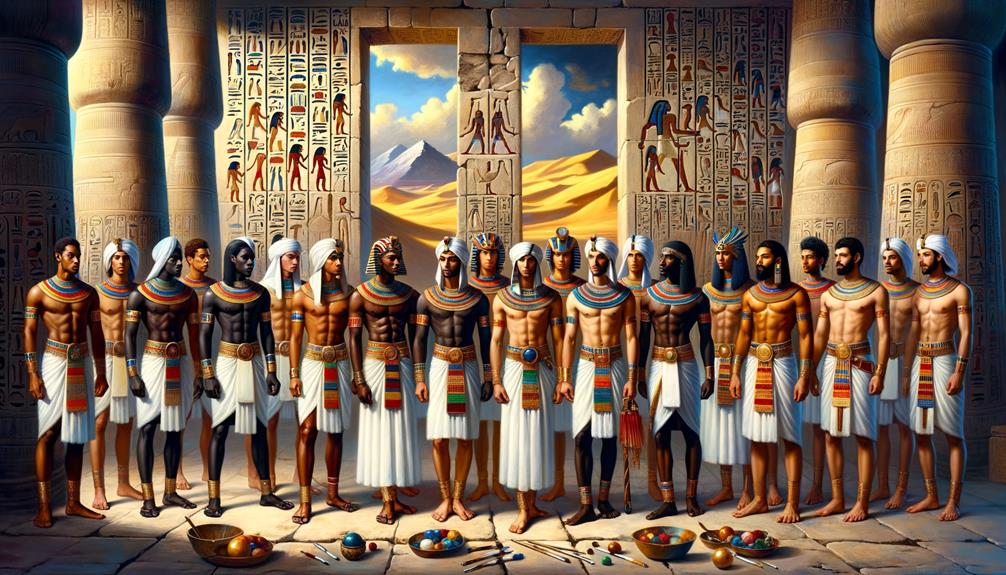
As I delved into ancient Egyptian fashion, I noticed that men commonly wore linen kilts tied at the waist, a practical choice for the sweltering climate. This simplicity facilitated movement and provided much-needed comfort. However, the attire of upper-class men highlighted their elevated status through the use of finer materials and intricate designs.
Linen kilts were a staple in men’s fashion, often made from lightweight linen and tied at the waist, extending to the knees. Some kilts even featured pleats, adding a touch of sophistication.
Professions had distinct clothing. Scribes typically wore kilts paired with sheer blouses, while priests donned white linen robes, symbolizing purity.
Pharaohs’ garments were truly elaborate, featuring materials like gold-threaded linen and adorned with jewelry and the iconic nemes headdress, reflecting their divine authority.
This varied spectrum of Egyptian clothing for men showcased their societal roles and personal status. While men and women wore similar basic garments, the details differentiated them. Upper-class men, in particular, used fashion as a means of displaying wealth and power, a tradition that resonates through centuries.
Women’s Attire
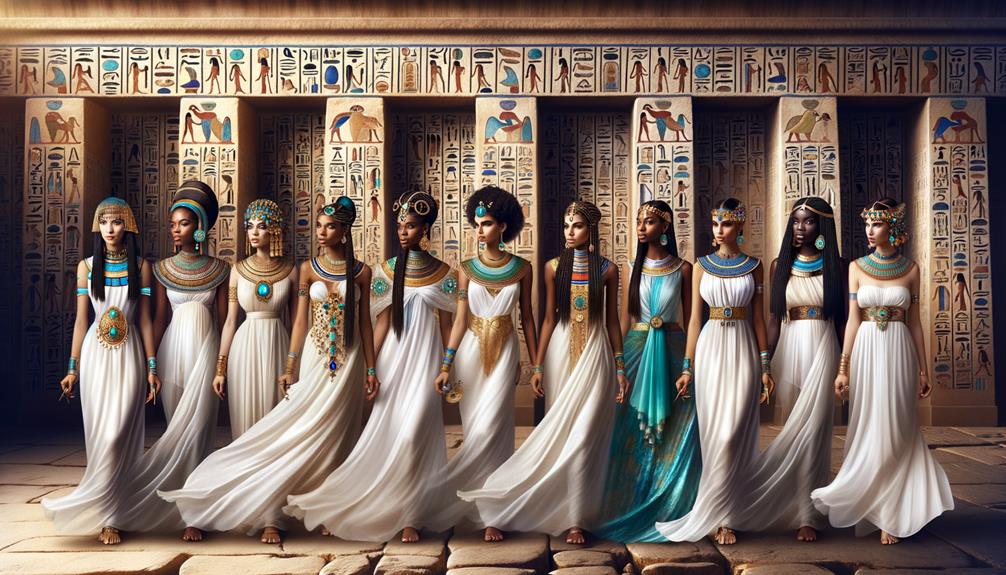
In ancient Egypt, women’s fashion was all about elegance and sophistication. They wore beautifully draped linen dresses that accentuated their figures, showcasing their social status and refinement. The wealthy opted for lighter, more luxurious fabrics, often adorned with intricate beading, which added an extra layer of sophistication to their overall appearance. The delicate hemlines of these dresses would sometimes make a gentle rustling sound as the women walked, creating a captivating auditory experience.
Elaborate hairstyles were a crucial part of a woman’s ensemble. Since head shaving was a common practice, women would don intricately styled wigs featuring pleats, fringes, and layers. These wigs weren’t just functional; they were also a canvas for artistic expression, reflecting the wearer’s personal taste and social standing.
Accessories played a vital role in completing the overall look. Upper-class women adorned themselves with ornate jewelry and diaphanous gowns, flaunting their wealth and social position. The interplay of sheer fabrics and lavish adornments created an otherworldly elegance that was both timeless and innovative. In essence, the attire of ancient Egyptian women was a carefully crafted blend of simplicity and opulence, reflecting their social roles and personal identities with subtle nuance.
Footwear Styles
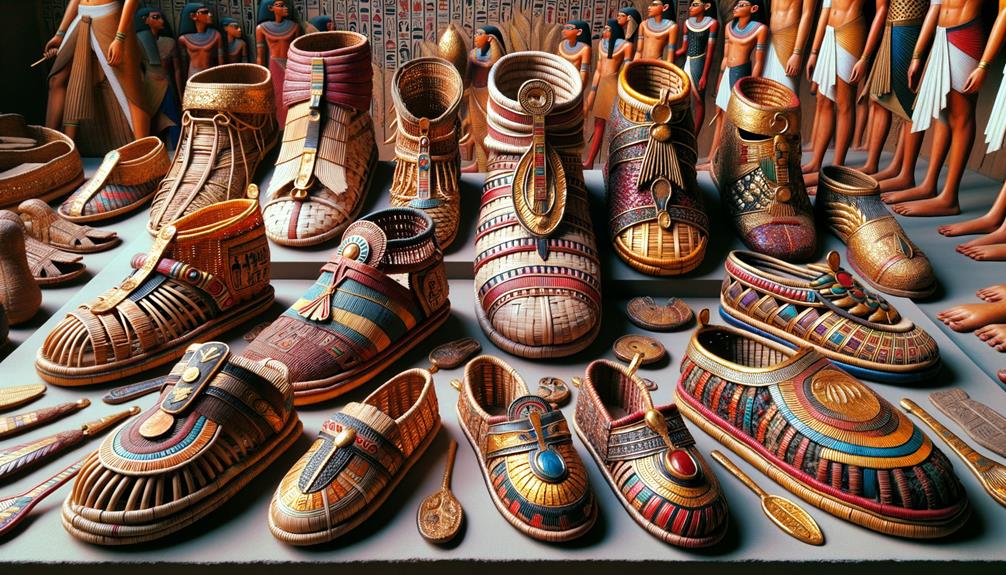
Drawing inspiration from nature, ancient Egyptian footwear masterfully combined function with artistic flair. In the scorching Egyptian sun, practicality was key, yet artisans still managed to infuse their creations with elegance. The Deshret and Hekt sandals, crafted from papyrus and leather, exemplified this perfect balance. These were not mere utilitarian objects, but a testament to innovative fashion.
Ancient Egyptian footwear came in various styles, each with its unique charm and purpose:
Deshret Sandals, made from woven papyrus, were lightweight and breathable, ideal for the arid climate.
Hekt Sandals, fashioned from durable leather, provided a sturdier option, adorned with intricate designs and colorful beads.
Goblet Sandals, crafted from animal hide, were favored by men for their stability and flat soles, perfect for everyday wear.
The footwear was often secured with straps around the ankle or calf, adding both style and practicality. Ancient Egyptians’ approach to sandals, with their unique materials and designs, continues to inspire modern fashion. They were not just innovative in their use of resources but in their ability to blend function and beauty seamlessly.
Accessories and Adornments
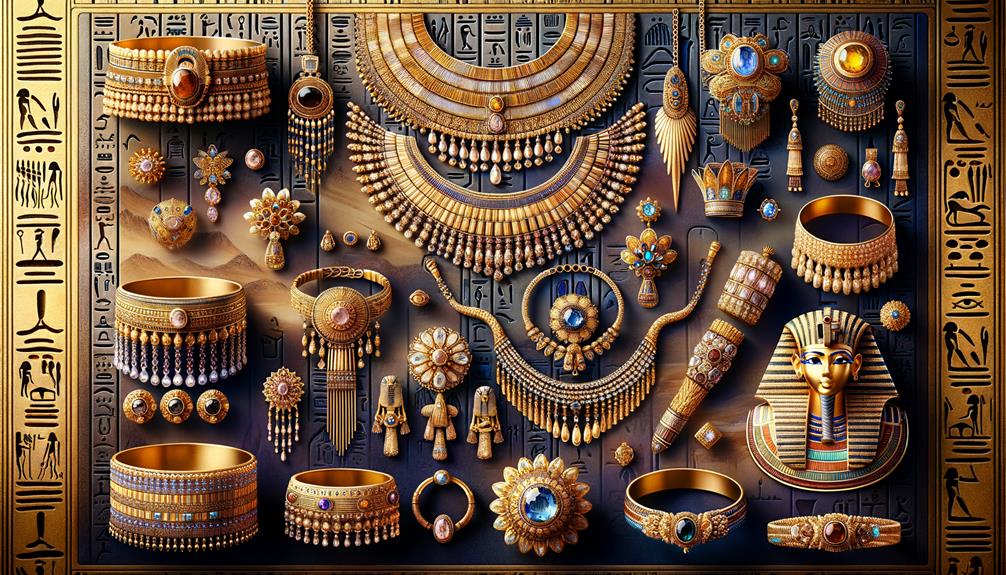
Ancient Egyptians showcased their flair for elegance and attention to detail by adorning themselves with vibrant jewelry and meticulously crafted wigs. Their jewelry, featuring gold and semi-precious stones like carnelian and amethyst, adorned neck collars and wristbands, creating a stunning visual display against their clothing and footwear. The simple yet elegant linen garments with pleated sleeves and ornamented kilts provided a perfect backdrop for these opulent accessories.
Wigs, often made from human hair and date palm fibers, were a status symbol for the wealthy, adding an air of sophistication to their overall look. These wigs, sometimes adorned with perfumed fat cones, emitted fragrant scents, enhancing the wearer’s allure. The iconic black kohl eye shadow framed their eyes with dramatic precision, serving both as protection and a beauty statement.
Glass and faience beads, woven into intricate patterns, were popular, adding an innovative touch to their adornments. Even woven papyrus found its place in the creation of accessories, showcasing the Egyptians’ resourcefulness. Each element, from the materials to the craftsmanship, spoke to their cultural emphasis on beauty and social standing. Their approach to fashion was not just about attire; it was a holistic expression of identity, reverence for the divine, and a reflection of their sophistication.
Frequently Asked Questions
What Was Fashion Like in Ancient Egypt?
Fashion in ancient Egypt was a perfect blend of style and practicality. Both men and women preferred lightweight, breathable fabrics for their clothing, which often featured intricate details. Their beautifully adorned sandals showcased their creative flair.
What Is the Traditional Fashion of Egypt?
In traditional Egyptian fashion, imagine flowing linen garments, adorned with dazzling jewels and intricate hairstyles. It’s a scene where practicality meets luxury, each piece carefully crafted to harmonize with the intense desert sun and ancient heritage.
What Is the Ancient Egypt Style?
Ancient Egypt’s style, characterized by lightweight linen garments, exudes an effortless sophistication. Both men and women wore simple, yet elegant attire, with men donning tunics and kilts, while women wore dresses and skirts. This ancient style has remained influential, blending comfort with an air of regal simplicity.
What Fashion Accessories Did They Wear in Ancient Egypt?
In ancient Egypt, people wore some unique fashion accessories. They donned wigs made from human hair, date palm fibers, and even perfumed fat cones. Jewelry made from gold, carnelian, and amethyst adorned their bodies, accompanied by beaded shawls, feathers, capes, and robes. These ancient Egyptians were truly innovative with their fashion choices.



